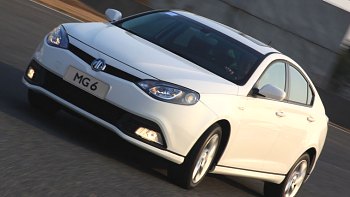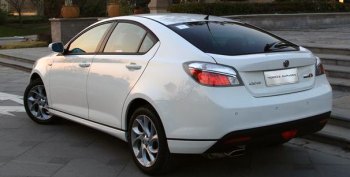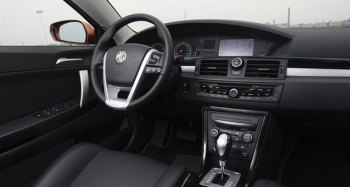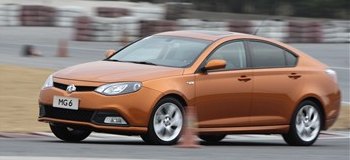MG 6
Debut: 2009 |
||||||||
2005 was a sad year to British motor industry. On the 8th of May, MG Rover, the last British-owned mass production car maker, ran out of cash and stopped rolling out cars from its Longbridge plant. After some negotiations, administrator sold the MG marque and most production equipments to Chinese car maker Nanjing Auto. This signaled the end of the genuine MG cars and the start of Chinese-built MG cars. Initially, Nanjing produced a clone of Rover 75 (MG ZT) called MG 7, as well as a handful of updated MG TF. They failed to make any impact to the market, of course. In 2007, Nanjing itself was acquired by the much larger Shanghai Automotive Industry Corporation (SAIC) under the guidance of government. With the availability of new fund, the group established an R&D center at the old Longbridge site, hiring British engineers and designers to produce a couple of new cars based on the platform of Rover 75. The first one was Roewe 550, launched in 2008. The second was MG6, debuted in the China market in December 2009. It is also the car we going to talk about.
If you have not heard of Roewe 550, I suggest you to read our Roewe 550 report first, because this will give you some useful background information. Basically, MG6 is a Roewe 550 with different packaging and suspension tuning. While the Roewe is a conventional 3-box saloon targeting primarily at the domestic market, MG6 is a 5-door hatchback destining to both China and Europe, at least according to its plan. The company knows European customers prefer hatchbacks to sedans, and a handling and ride characteristic biasing towards the sporty side. These two requirements dictate the design and tuning of the MG. Having learned this, it is not difficult to understand MG6. While key dimensions and positions of hard points are the same as its sister car, its exterior design is much sportier. A fastback, "four-door coupe" profile has been chosen to keep it at the forefront of fashion. Its nose and headlights are quite stylish, certainly much more than the tail. A rising waist line and sloping roof line lead to shallow side glass, so the interior looks dark and confined, especially to the rear passengers. The latter will also find headroom in short supply. People over 5 ft 10 in will have their heads touching the roof lining, although there is enough legroom for 6-footers.
To save money, the MG6 keeps the dashboard of Roewe 550, whose ordinary design is out of sync with its sporty exterior. Build quality is good by the standard of Chinese cars, but not good enough to match European offerings. Plastics look plasticky. Fake alloys look just fake. The "Le Mans" digital instrument reading of Roewe has been replaced with conventional dials, though it still fails to impress. The only upside is luggage space, measuring 430 liters normally or 1380 liters with rear seats folded. The hatchback door makes loading luggage easier. Like its sibling, MG6 offers two outdated engines – 1.8-liter VVT with 133hp and 1.8-liter turbo with 160hp. Both were developed from Rover K-series. As in Roewe 550, the naturally aspirated engine is underpowered, while the turbocharged unit has some turbo lag, lacking shove below 2500 rpm. Most European turbo engines solved this problem by integrating the turbocharger with exhaust manifolds, but the Rover-based engine is just too old to adapt. Mating with a 5-speed manual or a slow-reacting 5-speed Tiptronic automatic gearbox does not help. As a result, its performance is far from satisfying.
To distinguish its driving manner from Roewe, MG6 employs much stiffer springs and dampers in its MacPherson struts and Z-axle suspensions, and a set of slightly lower profile tires. As a result, it resists body roll strongly through corners. On fast roads, its handling is more surefooted, and the damping overcomes speed bumps cleanly. Steering is weighty and precise. Nevertheless, the tradeoff is a very stiff ride on less than smooth surfaces. Low-speed bumps and broken pavements are felt through the seats, dashboard vibration and noise. The updated Rover 75 platform seems neither rigid nor well insulated enough to take on such a sporty tuning. In fact, the tuning of its Roewe sister is actually better judged. Considering competition in Europe is so intense, I don't think MG6 can make a business case there. European buyers will expect a better built and more stylish cabin, better powertrain and better running refinement. Moreover, the Chinese MG's heavy fuel consumption and excessive carbon-dioxide emission will win few friends in Europe. Lastly, SAIC needs to persuade people to believe this is a real MG rather than a badge-engineered Chinese product, which is perhaps the most difficult task. If it think assembling the car at Longbride from knockdown kits would be the solution, then I can only say good luck to it. |
||||||||
| The above report was last updated on 15 Mar 2010. All Rights Reserved. |
| Specifications | ||||||||||||||||||||||||||||||||||||||||||||||||||
|
|
||||||||||||||||||||||||||||||||||||||||||||||||||
|
|
||||||||||||||||||||||||||||||||||||||||||||||||||
|
||||||||||||||||||||||||||||||||||||||||||||||||||
| Performance tested by: *Autocar |
Copyright©
1997-2010
by Mark Wan @ AutoZine



